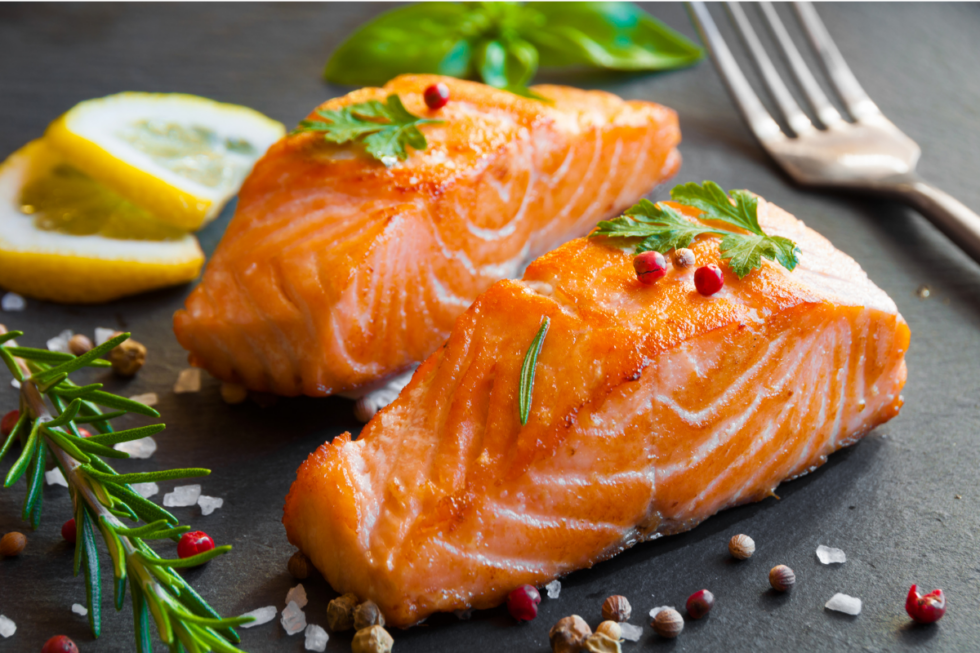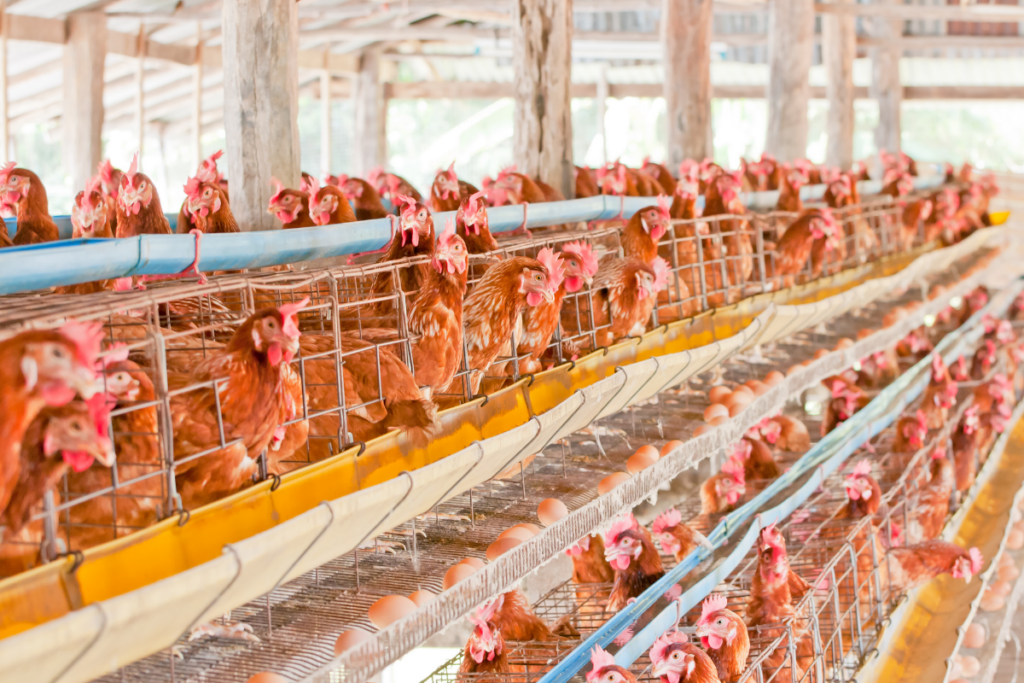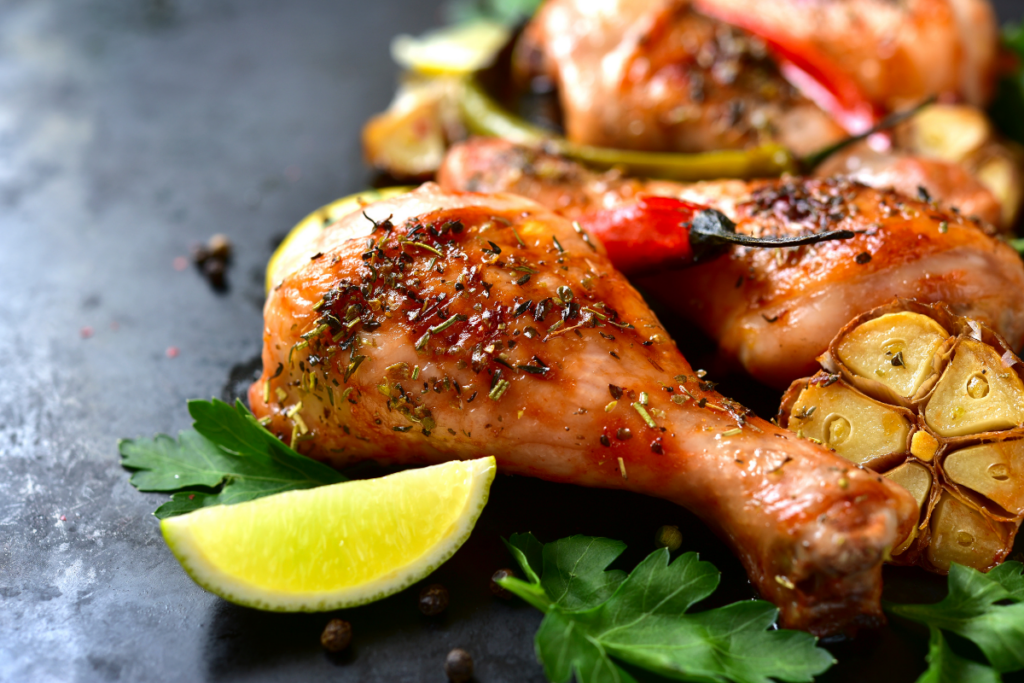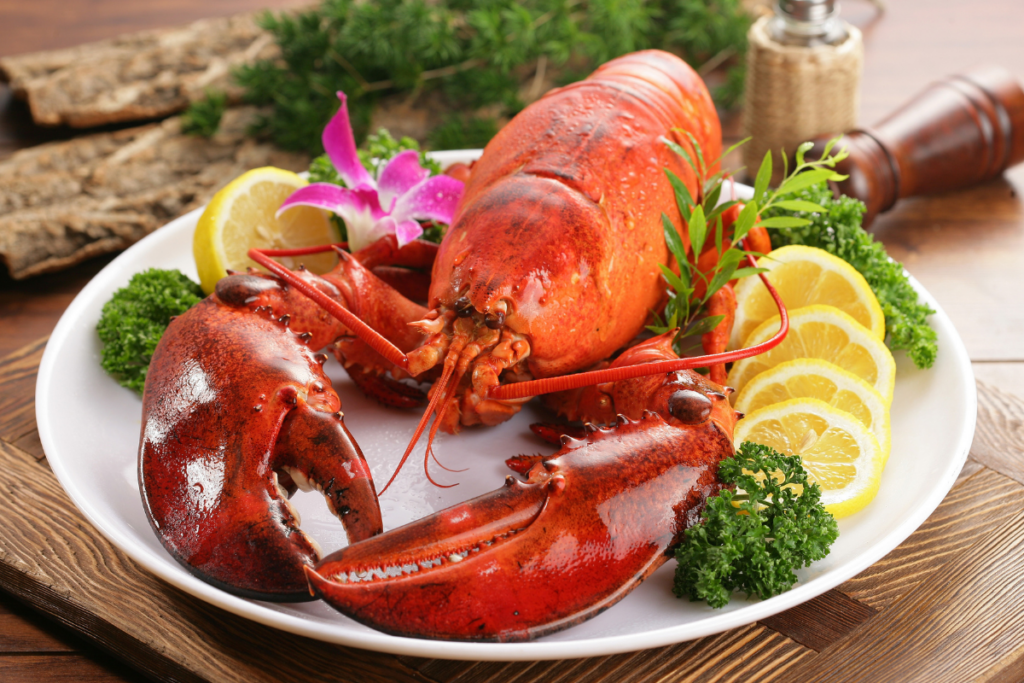
The Best Low Histamine Meat and Seafood Options – info for those with Mast Cell Activation Syndrome and Histamine Intolerance
Whole Foods knew me by name.
It wasn’t just because I shopped there …
They knew me by name because I would call them every week to find out what day the meats were being delivered.
Back then, I wasn’t tolerating many foods at all. The only animal protein I had found I could tolerate was chicken from Whole Foods… sometimes… but only if it was really fresh.
So, I’d call them…each and every week. I’d find out that week’s delivery schedule for chicken. And then I’d arrive at the store within an hour or two of delivery. I’d go straight to the butcher counter and ask for what had just come in.
Then I’d bring it home and cook it all, freezing the leftovers for the week.
Sadly, I’d only find out a few days later whether I would have mast cell and histamine reactions or not to each week’s batch of chicken.
Some weeks I was fine.
But sometimes I’d still get histamine reactions in the form of diarrhea, itching, anxiety, and sleep issues. Yuck!
Eventually I figured out that it could take anywhere from 2 to 7 days for the chicken to get from the farm to Whole Foods. There was no way of predicting or knowing each week how fresh the chicken would be.
Back then, there were very few low histamine meat options in general. I did my best with the resources I had. At that time, I was only tolerating 10 foods. When it was fresh, chicken was one of them.
So, I kept that option open even if it was a gamble.
Eventually, though, I learned you could get meat that had been frozen after slaughter!
And I even discovered seafood sources that are low histamine!
When I found these low histamine meat and seafood sources, it was a game changer for me. I now have variety. And I don’t have to worry about having reactions.
I am so happy that I can get bison, beef, salmon, and elk (my favorite these days) in addition to chicken. I can even have scallops and sashimi on special occasions!
And I don’t have to call the store every week or drive across town!
I’m going to break down the top do’s and don’ts for low histamine meat and seafood for you. Then we’ll take a closer look at these favorite options for low histamine meats:
- Northstar Bison
- Use code MASTCELL360 for 10% off at Northstar Bison
- White Oak Pastures
- Use code MASTCELL360 for 10% off your first order at White Oak Pastures
- Vital Choice Seafoods
I hope this information will help you be able to enjoy eating more low histamine protein foods!
Histamine Levels in Meat – What to know if you have Mast Cell Activation Syndrome or Histamine Intolerance

Let’s start with why histamine levels in meat can be high. (I’m using the word “meat” in reference to all animal proteins, not just red meat.)
Bacteria can grow very quickly on meat. This is especially true of unfrozen meats. Under certain conditions, bacteria can double in number every 20 minutes!
Many strains of bacteria on meat are histamine-producing.
More bacteria on meat = more histamine.
Microorganisms like bacteria need these things to grow:
- Food
- Acidity
- Temperature
- Time
- Oxygen
- Moisture
These growth factors go by the acronym FAT TOM.
Any food, under certain circumstances, can be an environment for bacteria to thrive.
Meats are especially prone. When we look at the FAT TOM factors, we see that meat can hit them all.
Let’s start with the obvious. Food. Meat is a food source. We are going to use it as our food, too, after all!
Next, meat is considered acidic, in terms of pH. Quality meat is generally in the pH range of 5.7 – 6.0. A pH less than 7 is considered acidic. Acidity isn’t necessarily bad in foods. In this case, we just mention it because it is one of the FAT TOM factors.
And meat does have moisture. Water content is present in all animal protein.
We really can’t do anything about these three factors. And that’s ok. It doesn’t mean that meat should be avoided. All our food is going to be a food source and have moisture!
But you can change some of the other factors to keep bacteria…and histamine…lower.
Oxygen is in the air around us, so naturally meat is going to be exposed to it. Meat can be exposed during the time it takes to process it. This is also something that can’t be avoided.
But if the meat is frozen and packaged as soon as possible after processing, that goes a long way to reducing the exposure.
Oxygen exposure can also occur during the time it sits in the butcher or fishmonger’s case at the store. This leads into another factor which we can do something about: time.
When I was calling Whole Foods every week, I was trying to account for the time variable. I was trying to get the meat as fresh as possible.
See, if you just pick up unfrozen meat from the grocery with your regular shopping, you really don’t know how old the meat is.
You don’t know how long it was in transit.
And you don’t know how long it has been sitting unfrozen at the store.
It is not uncommon for unfrozen meat and fish to sit for a week or more either in the butcher’s case or the refrigerators. That’s more time for bacteria to grow.
Aging meats is another way in which time is a factor. Most beef and bison are aged. For many cuts of these meats, they are aged up to 21 days! Anything aged is going to be higher histamine.
You can make time less of a factor by buying unaged meats that are immediately frozen after slaughter. Freezing goes along with the temperature factor, too, which we will look at next.
Temperature is the final FAT TOM factor. We can do something about that, too. You probably already know this. It’s why you keep perishable items, like meat, refrigerated or frozen.
It’s also why getting meat that is frozen immediately after slaughter is ideal. And it’s why I recommend keeping meat frozen until you are ready to cook it.
Bacteria don’t reproduce as quickly when meat is frozen.
40°F is the low end of what is considered the “danger zone” for meat. Bacteria grow quickly in the danger zone. Even for someone without histamine issues, 2 hours in the danger zone is the max.
It’s recommended by the FDA that most refrigerators be below 40°.
So, if your refrigerator was at 39°, that technically wouldn’t be in the danger zone.
But refrigerators fluctuate in temperature.
If you open the door a lot, the temp will rise.
If you put hot foods in the refrigerator, that can cause change.
If your filters aren’t cleaned regularly, that can cause temperature changes, too.
Even the different areas in your refrigerator vary in temperature. The door compartments tend to be warmer, and the crisper tends to be cooler.
If you have health issues, like Histamine Intolerance, controlling the temperature can make a huge difference. You want to do everything you can to keep bacteria growth to a minimum.
So that’s why I recommend keeping everything frozen until you are ready to cook it. You don’t have to worry about temperature fluctuations in your fridge.
And even though meats kept at temperatures in the upper 30s would be out of that danger zone, histamine levels will still increase faster than if the meat is frozen.
A final factor is surface area.
Ground meats collect bacteria even faster. This is due to increased surface area.
Without getting too technical, that’s basically just providing more surface area for bacteria to feed and thrive.
Surfaces create at least two of the FAT TOM factors: more exposure to the air (oxygen) and increased moisture from the air, too.
As you can see, meat can be the perfect environment for histamine-producing bacteria. But don’t worry. It doesn’t mean you can’t have it. I’ve got some great solutions for you.
But first, if you have Mast Cell Activation Syndrome, Histamine Intolerance, or other food sensitivities, there is one more thing to know about to make sure the meat you are eating is as healthy for you as possible.
You want to know about what’s hiding in conventionally raised meat.
We’ll look at that next.
What’s Hiding In Meat? – What to know if you have Mast Cell Activation Syndrome or Histamine Intolerance

First, if you’ve never seen a conventional farm for livestock – well…it’s not a pleasant experience.
I grew up in the country where there were massive chicken farms. The chickens never went outside. And they were kept in tiny cages where they couldn’t even stand up, much less turn around.
The smell alone was horrendous.
Cows and pigs are often raised in similar crowded environments.
In these kinds of environments, the animals are highly stressed and get sick constantly.
Because of this, these animals are pumped full of antibiotics. They also have very high levels of cortisol and other stress hormones.
And they’re given huge amounts of growth hormones to make them grow as quickly as possible to maximize profits.
In addition to concern for animal welfare, all these chemicals and hormones stay in the meat you eat, unfortunately.
Further, conventionally raised livestock are often fed wheat, corn, and soy.
In a natural environment, cows would not eat these things. They would graze on grass.
Now, I do know that cows, chickens, and pigs are domesticated and eat what humans give them. But I’m talking about their natural, wild relatives.
They eat grass and insects instead of grains. That’s what gives wild game a much better nutritional profile.
And, this is why conventional meat has high inflammatory fats called Omega 6s and arachidonic acid. These are well-known to trigger mast cells.
But, in wild game and in animals that are raised on grass and hay – they have high anti-inflammatory fats called Omega 3s.
Those Omega 3s are really important for supporting mast cells. But most Omega 3 supplements are from fish oil that is high histamine.
This is why for those of us with mast cell issues, high-quality, low-histamine meat and seafood are often the best option for us for Omega 3s.
Now, if you have a lot of sensitivities to wheat, corn, or soy, there can be another issue for you with conventional meat.
Grains, especially wheat grains, fall in the gluten category. Gluten tends to be a problem with many of my clients. Gluten proteins can set off the mast cells. And of course, mast cells can release the mediator, histamine.
Grains also tend to fall in the lectin category. So, if someone is gluten sensitive or lectin sensitive, grains tend to be a problem.
You can read more about gluten sensitivity and how it can affect someone with MCAS or Histamine Intolerance here: Are Wheat and Gluten Really Mast Cell and Histamine Triggers?
Many people in the sensitive population have stated that, if they have a strong sensitivity to gluten, they may notice increased symptoms when they eat conventionally raised meat. They don’t experience this with grass-fed (also called pastured or pasture-raised) meats.
Sometimes, grass-fed animals may get some of these grains in the winter when grass is sparse. But, it’s a lot less than conventionally raised animals.
This is one of the reasons I ask my clients to keep a Food and Symptoms Journal. Sometimes you may have a reaction even when you think you are doing everything by the books. But with a journal, you can start to pinpoint sensitivities and where triggers may be hiding out in your foods.
Now, some people with a healthy gut and healthy immune system may be able to process this secondhand exposure without any issues. The digestive process when working normally can break down these things.
But so many people with Mast Cell Activation Syndrome and Histamine Intolerance are in such a challenging place with their health. Just like I was when I could only tolerate 10 foods. And for those people, normal processes may not be working as they should.
The body’s systems may not function properly due to toxic overload, mold, or even solely from food sensitivities. But any way we approach it, we try to be mindful of the most sensitive in our community. That’s because so many of us do fall in that category.
So, with all these factors, are there even safe options for meat?
The answer is YES! There are safe options for all kinds of meats. We’ll go over those next.
Low Histamine Meat Options – What to know for those with Mast Cell Activation Syndrome and Histamine Intolerance

There are a lot of low histamine meat options these days. This is so exciting!
Good quality meat and seafood can offer several health benefits.
Meat is nutrient dense and a good source of the nutrients: B12, creatine, DHA, heme iron and more.
Vitamin B12 is an essential vitamin that your body needs. However, your body does not produce this on its own.
It has many roles in the body including maintaining nerves and normal brain function.
It is also essential for the metabolism of proteins and fats. It’s also important in immune system balance.
Creatine helps muscle cells by giving them greater strength and endurance.
Your body does make this, but studies have shown that those who eat meat will have higher levels of it in their muscles.
It’s very popular as a supplement for body builders and other athletes since studies have shown that it can increase muscle mass and strength. But we all need some creatine to have normal muscle strength.
DHA (Docosahexaenoic acid) is a type of essential omega-3 fatty acid.
It’s important for normal brain development and function. Numerous studies have shown that DHA is very important for stabilizing mast cells. One paper reported a 40-50% reduction of mast cell mediators with healthy fatty acid levels.
Heme iron is only found in meat, especially red meat.
Low iron has been shown to be a mast cell trigger.
But, many iron supplements aren’t well absorbed and can become inflammatory. And that worsens mast cell issues.
Heme iron in animal protein is better absorbed than non-heme iron, which is what is found in plant foods. Good food-based iron intake can prevent iron deficiency and anemia.
So, you can see where meat can offer nutrients to support your body’s functions and go a long way to helping your mast cells.
So, where do you find grass-fed meat that is frozen after slaughter?
You can get good quality, low histamine options from several places now. And it’s shipped right to you. I’m going to walk you through 3 companies that are committed to providing high quality, grass-fed, low histamine options.
These companies all ship frozen on dry ice. I’ve received my orders in 100° weather just fine.
Each of these companies has great customer service, too. Whenever I’ve needed to reach out, they were helpful with answering my questions. They were informative and easy to talk to.
Only once did I experience an issue with a product. In one delivery, there wasn’t enough dry ice. This caused the meat to thaw prematurely. The company sent out replacements immediately with no fuss.
And, if you have a deep freezer, some of them will sell to you in bulk, which is more economical.
Note – There are likely other companies that are also providing great low histamine meat options. These are the 3 companies I know well, am comfortable with, and have ordered from as of the writing of this blog post.
Let’s start with Northstar Bison.
Northstar Bison

Northstar Bison as a company is very aware of histamine issues, and they maintain a large selection of low histamine meats!
All their meat is grass fed from start to finish. When you look at pasture-raised meat, the Omega 3 profile and other nutrient availability is excellent.
Northstar has an impressive commitment to the quality and health benefits of the meat and salmon they provide. Their options are all:
- Hormone & Antibiotic Free
- Non-GMO
- Organically Raised
- Preservative Free
- Minimally Processed
- 100% Soy-Free
- 100% Corn-Free
- 100% Gluten-Free
They also place a huge emphasis on environmental concerns, including sustainable ranching, harvesting, and use of the entire animal with no waste.
Their low histamine options include:
- Unaged Bison
- Elk
- Chicken
- Turkey
- Rabbit
- Lamb
- Salmon
- Halibut
You may not have tried some of these proteins before. But for those with food allergies, sometimes switching animal proteins can be helpful. It can allow the immune system to calm down. If your diet usually relies on chicken and turkey, you might explore different options.
My 3 favorite meat options are rabbit, elk, and salmon. I like to make a stew with their elk and rabbit.
Related Post: Meat Broth Recipe
Both rabbit and elk are great food sources of heme-based iron – the form our bodies can most easily use. These are also excellent sources of B12 in food form.
And all of these are great sources of creatine and DHA as well.
If you’re less histamine intolerant (like I am these days), you may do well with their pork, ground elk, and ground bison. I’ve really enjoyed making elk and bison burgers. These also work great in stews.
I still have trouble with ground chicken, turkey, and pork from my local farmer – still not sure why – it may be because it doesn’t get frozen as quickly as would be helpful for me.
But, I’ve done great with Northstar Bison’s ground meats.
They’ve offered 10% off for our Mast Cell 360 Community – thank you so much Northstar Bison!!
>>>>Get 10% off Northstar Bison with this link and code MASTCELL360
Next, let’s look at another favorite company, White Oak Pastures…
White Oak Pastures

I was delighted when I found this company was producing unaged beef! Their meats are frozen after slaughter, which is great for keeping histamine levels down.
Low Histamine Options from White Oak Pastures include:
- Unaged beef options
- Chicken
- Turkey
- Lamb
- Duck
- Pork
Sometimes they have other special options, too. When in stock, you can also choose from guinea fowl, goat, boar, rabbit, and alligator. Again, these options can be good if you have a lot of food sensitivities and need to rotate your proteins.
Most beef is aged. It’s rare to find unaged beef because aging makes meat tender and flavorful. But, we know that aging is higher histamine.
That’s why I was so excited to find out White Oak has numerous grass-fed, unaged beef options.
Some of their cuts of unaged beef are much more tender than you’d expect. I really like their tips and tails for stir-fry– these are tender cuts of beef that just need searing.
For our anniversary, I got their unaged beef filet mignon – it was the most delicious beef I’ve ever had. You could cut it with a butter knife!
They do have aged beef, too, but it’s clearly marked. Just be sure to check the pictures and descriptions.
I’ve also done well with White Oak Pastures’ ground meats. But if you’re still really histamine sensitive, you’d have to test it for yourself to see if it works for you.
As your body heals and you can tolerate more things, you might be able to go with the convenient option of pre-ground meats from a quality company.
Until then, I’d still suggest grinding your own meat. This is the meat grinder I’ve used to make my own ground meats.
White Oak Pastures has offered our community 10% off your first purchase with them. Thank you, White Oak Pastures!
Here’s how to get the discount:
>>>>Get 10% off first purchase for White Oak Pastures with this link and code MASTCELL360
Local Farmers
Local farmers can be a good source of meat as well. You need to ask questions, though. You’ll want to ask how soon after slaughter they freeze their meats.
You may be able to find chicken, lamb, turkey, and pork locally.
If you are looking for local farmers, web searches, the farmer’s market, or online forums can help you find someone in your area.
I’ve had a very hard time finding unaged beef or bison locally, though. And when my iron started getting low, I knew I’d have to have some protein options that were higher in heme-based iron.
These companies above were a game changer for me because of the options!
For a special meal, if tolerated, consider pairing your favorite low histamine meat with a lower histamine wine.
Low Histamine Seafood Options – What to know for those with Mast Cell Activation Syndrome and Histamine Intolerance

Seafood can be a great source of vitamin D3, omega 3s and zinc. All 3 of these are very important immune and mast cell supporting nutrients.
But other than wild-caught salmon, there really aren’t any other safe seafood options at the grocery.
Once I was able to introduce more foods into my diet again, I tried wild-caught salmon from Whole Foods.
But just the same as the chicken I’d get, it was hit or miss. A lot of this likely had to do with how long after catch it was processed and frozen.
These days, I’ve been getting my seafood from places where I know they are diligent about freezing after catch.
And, it’s important to get wild-caught seafood.
That’s because farmed seafood is fed grains. This presents the same health concerns as conventional meat that you read about earlier.
Let’s look at the options I’m most familiar with for low histamine seafood.
Vital Choice

I really want to highlight Vital Choice. They are committed to quality and provide some great low histamine options.
Vital Choice emphasizes wild-caught seafood for the health benefits. According to the USDA, a small fillet of wild salmon has at least 100 fewer calories and half the fat content of farmed salmon.
And recent studies have shown that farmed salmon have higher levels of pollutants that have been linked to diabetes and obesity.
Farmed salmon are also fed a lot of antibiotics, again because of crowding that causes disease.
Plus, farmed salmon has higher inflammatory Omega 6s from the grains and vegetable oils fed to them.
Wild salmon, on the other hand, has also been shown to have more Vitamin D, astaxanthin, and selenium than farmed as well.
If you are concerned about overfishing, it’s true that much of our wild-caught seafood is concerningly overfished.
This is why I love that Vital Choice has a commitment to ethical practices and sustainable catch.
This means they don’t participate in poor working conditions. And they’re making sure they don’t overfish so there can still be seafood for generations to come.
Most of their fish is caught without nets. This significantly reduces the issues with whales, sharks, dolphins, sea turtles, and other endangered species getting caught in fishing nets.
They have a number of low histamine seafood options.
Their lowest histamine option is their King Salmon.
If you are very histamine intolerant, this is where I’d recommend starting.
King salmon is rich in many mast cell-supporting nutrients, like Omega 3s, Vitamin D, zinc, and heme-iron.
Here are all their lower histamine options:
- Salmon, (King Salmon)
- Cod , (Alaskan, Ling)
- Petrale Sole
- Mahi Mahi
- Haddock
- Chilean Sea Bass
- Scallops (Wild Atlantic, Wild Petit Patagonia, Wild Alaskan)
- Lobster
- Albacore Tuna
That’s a lot of great choices!
And you’ll notice that there is even a shellfish listed.
Typically shellfish are higher histamine. But these histamine levels have more to do with the processing of the fish rather than the fish itself.
These scallops are lower histamine because they are shucked and frozen very soon after catch. That makes a big difference in histamine levels.
Try this with your order: Low Histamine Fish Recipe or Low Histamine Fresh Salmon Cakes
Now, Vital Choice does have higher histamine products, too. So, just stick to the list above.
This company offers quality options. But if you have histamine intolerance, you’ll probably still want to stay clear of any smoked, canned, or processed items like jerky, burgers, and bacon.
As far as the higher histamine seafood options, here are the ones to skip:
- Silver Salmon
- Arctic Keta Salmon
- Tataki
- Poke
- Halibut
- Sablefish (Black Cod)
You can find Vital Choice here:
>>>>>Order Low Histamine Seafood from Vital Choice here
I hope you will enjoy these low histamine options as much as I do. I’m so grateful to have these choices available to me now.
In an upcoming post, I’ll have some tips for you on storage and preparation. Be sure to check back!
Read Next:
- Meat Handling Tips: Preparation, Cooking, and Storage & what to know for those with Mast Cell Activation Syndrome or Histamine Intolerance
- Low Histamine Meal Plan Tips for Histamine Intolerance and Mast Cell Activation Syndrome
- Low Histamine Foods List for MCAS and Histamine Intolerance
- The Mast Cell 360 Guide to Our Favorite Kitchen Staples and Top Low Histamine Food Tips
*Some links in this website are affiliate links, which means Mast Cell 360 may make a very small commission if you purchase through the link. It never costs you any more to purchase through the links, and we try to find the best deals we can. We only recommend products that we love and use personally or use in the Mast Cell 360 practice. Any commissions help support the newsletter, website, and ongoing research so Mast Cell 360 can continue to offer you free tips, recipes, and info. Thank you for your support!
References for Low Histamine Meat and Seafood Options – What to know if you have Mast Cell Activation Syndrome or Histamine Intolerance
Anogeianaki, A., Castellani, M. L., Tripodi, D., Toniato, E., de Lutiis, M. A., Conti, F., Felaco, P., Fulcheri, M., Theoharides, T. C., Galzio, R., Caraffa, A., Antinolfi, P., Cuccurullo, C., Ciampoli, C., Felaco, M., Cerulli, G., Pandolfi, F., Sabatino, G., Neri, G., & Shaik-Dasthagirisaheb, Y. B. (2010). PGD2, IL-I-FAMILYMEMBERSAND MAST CELLS. SAGE Journals. Retrieved November 8, 2021, from https://journals.sagepub.com/doi/pdf/10.1177/1721727X1000800301
Bird S. P. (2003). Creatine supplementation and exercise performance: a brief review. Journal of sports science & medicine, 2(4), 123–132.
BSc, A. A., PhD. (2021, June 9). 7 Nutrients That You Can’t Get from Plants. Healthline. Retrieved October 30, 2021, from https://www.healthline.com/nutrition/7-nutrients-you-cant-get-from-plants#7.-Taurine
Burke, D. G., Chilibeck, P. D., Parise, G., Candow, D. G., Mahoney, D., & Tarnopolsky, M. (2003). Effect of creatine and weight training on muscle creatine and performance in vegetarians. Medicine and science in sports and exercise, 35(11), 1946–1955. https://doi.org/10.1249/01.MSS.0000093614.
17517.79
Cleveland Clinic. (2020, December 15). Fish Faceoff: Wild Salmon vs. Farmed Salmon. Retrieved November 1, 2021, from https://health.clevelandclinic.org/fish-faceoff-wild-salmon-vs-farmed-salmon/
de Maria Serra, F., Parizi, J.L.S., Odorizzi, G.A.S. et al. Subchronic exposure to a glyphosate-based herbicide causes dysplasia in the digestive tract of Wistar rats. Environ Sci Pollut Res (2021). https://doi.org/10.1007/s11356-021-15051-6
FAO. (1991). Guidelines for slaughtering, meat cutting and further processing. FOOD AND AGRICULTURE ORGANIZATION OF THE UNITED NATIONS. Retrieved October 29, 2021, from https://www.fao.org/3/t0279e/T0279E03.htm
Hagenlocher, Y., & Lorentz, A. (2015, January 1). Immunomodulation of mast cells by nutrients. ScienceDirect. Retrieved November 8, 2021, from https://www.sciencedirect.com/science/article/
abs/pii/S0161589013005853
Hale, L. P., Kant, E. P., Greer, P. K., & Foster, W. M. (2012). Iron supplementation decreases severity of allergic inflammation in murine lung. PloS one, 7(9), e45667. https://doi.org/10.1371/journal.pone.0045667 (Retraction published Hale LP, Kant EP, Greer PK, Foster WM. PLoS One. 2016;11(5):e0155387)
Higuera-Llantén, S., Vásquez-Ponce, F., Barrientos-Espinoza, B., Mardones, F. O., Marshall, S. H., & Olivares-Pacheco, J. (2018). Extended antibiotic treatment in salmon farms select multiresistant gut bacteria with a high prevalence of antibiotic resistance genes. PloS one, 13(9), e0203641. https://doi.org/10.1371/journal.
pone.0203641
Klont, R. (2005, November 21). Pig outlook: Lean hog futures prices in a free-fall. The Pig Site. Retrieved October 30, 2021, from https://www.thepigsite.com/articles/influence-of-ultimate-ph-on-meat-quality-and-consumer-purchasing-decisions
Lu Z, Chen TC, Zhang A, Persons KS, Kohn N, Berkowitz R, Martinello S, Holick MF. An evaluation of the vitamin D(3) content in fish: Is the vitamin D content adequate to satisfy the dietary requirement for vitamin D? J Steroid Biochem Mol Biol. 2007 Mar;103(3–5):642– doi:10.1016/j.jsbmb.2006.12.010
Mayo Clinic Staff. (2019a, October 18). Iron deficiency anemia – Symptoms and causes. Mayo Clinic. Retrieved November 1, 2021, from https://www.mayoclinic.org/diseases-conditions/iron-deficiency-anemia/symptoms-causes/syc-20355034
Miranda, C. D., Godoy, F. A., & Lee, M. R. (2018). Current Status of the Use of Antibiotics and the Antimicrobial Resistance in the Chilean Salmon Farms. Frontiers in microbiology, 9, 1284. https://doi.org/10.3389/fmicb.2018.01284
Office of the Commissioner. (2021, February 9). Are You Storing Food Safely? U.S. Food and Drug Administration. Retrieved October 30, 2021, from https://www.fda.gov/consumers/consumer-updates/are-you-storing-food-safely
Pavlov, C. S., Damulin, I. V., Shulpekova, Y. O., & Andreev, E. A. (2019). Neurological disorders in vitamin B12 deficiency. Terapevticheskii arkhiv, 91(4), 122–129. https://doi.org/10.26442/00403660.2019.04.
000116
Rink, L. (2007, February 28). Zinc and the immune system | Proceedings of the Nutrition Society. Cambridge Core. Retrieved November 8, 2021, from https://www.cambridge.org/core/journals/
proceedings-of-the-nutrition-society/article/zinc-and-the-immune-system/23B26245CF0F773E5F1AA19E9800B82B
Russell, N. J. (2002, November 15). Bacterial membranes: the effects of chill storage and food processing. An overview. ScienceDirect. Retrieved October 30, 2021, from https://www.sciencedirect.com/science/article
/abs/pii/S0168160502001769
The Department of Food and Nutrition Services. (2013, May). Food Bytes. University of Iowa Health Care. Retrieved October 29, 2021, from https://www.healthcare.uiowa.edu/fns/
Nutritional/Food%20Bytes/2013-05.htm
Valenzuela, C., de Romaña, D. L., Olivares, M., Morales, M. S., & Pizarro, F. (2009). Total iron and heme iron content and their distribution in beef meat and viscera. Biological trace element research, 132(1-3), 103–111. https://doi.org/10.1007/s12011-009-8400-3
Vicente-Zurdo D, Gómez-Gómez B, Pérez-Corona MT, Madrid Y. Impact of fish growing conditions and cooking methods on selenium species in swordfish and salmon fillets. Journal of Food Composition and Analysis. 2019;83:103275. doi:10.1016/
j.jfca.2019.103275
Yip, PhD, K., Kolesnikoff, PhD, N., Yu, BSc, C., Hauschild, BSc, N., Taing, BSc, H., Briggs, BSc, L., Goltzman, MD, D., Gregory, PhD, P. A., Anderson, PhD, P. H., Samuel, PhD, M. S., Galli, MD, S. J., Lopez, PhD, A. F., & Grimbaldeston, PhD, M. A. (2014, May 1). Mechanisms of vitamin D3 metabolite repression of IgE-dependent mast cell activation. ScienceDirect. Retrieved November 8, 2021, from https://www.sciencedirect.com/science/article
/abs/pii/S0091674913018514




Thanks to this blogpost I was able to expand the variety of low histamine proteins I am eating!
Just wanted to share a tip that I’ve recently learned myself and used successfully. You don’t have to have a grinder to grind your meat. It can be grinded in a blender or food processor.
Hi Olga,
So glad to hear this! Thanks for the tip! Yes, the key is that you grind it yourself and use it freshly ground. If a food processor works for you, that’s great!
Hello,
Should one be concerned about lead contaminating game meat that has been shot with lead bullets?
Also, are the higher histamine fish listed inherently higher histamine, or is it because of how they are prepared by Vital Choice? If they are frozen at sea by other companies, would they be lower histamine?
Thanks!
For fish, it’s about how quickly it’s processed and frozen after capture.
For meats, you can reach out to the company you are getting your meat from to see how they dispatch the animals and if lead is involved. There are varying points of view on this online and is not something we are well versed in. All we can say for sure is that for the companies that Beth gets her meats from, she has had no issues. She is very sensitive to toxins and has had no problems with meats from any of the companies listed here.
Please tell Dr. Beth how grateful I am for this article. I’ve been getting so tired of eating chicken :/ Super excited to buy something that’s packaged rather then grinding the meat myself. Question: I noticed that Beth recommends the halibut from Northstar bison but not Vital farms. Not sure if this was a mistake or that the halibut from vital farms not okay to buy? Thank you
Hi Ruth,
I didn’t look up all the halibut options on Vital Choice, but the one I just checked says it is flash frozen, so it should be fine, generally speaking. However, if you aren’t sure if you can tolerate halibut, you might want to start with just a few bites to see if you have any reactions. If not, you can slowly build up from there. I hope this helps!
If the fish they take the omega 3 oils from are full of these so-called “anti-inflammatory” oils why would the fish be high in histamine? That makes zero sense, to me.
Hi there! In our community, many people are very sensitive. So we don’t generally recommend fish oil supplements. Instead we use SPM Active.
One of the ways a food can develop higher histamine levels is through bacteria. The longer a meat sits unfrozen, the greater the chance of increased bacteria. And it follows that increased bacteria can mean higher histamine. So it isn’t always about the fish itself being low or high histamine. It often has to do with what happens after the fish gets caught. That’s why Beth likes the brands she talks about in this article. They freeze almost immediately after catch or slaughter which keeps histamine levels lower. I hope this helps!
Do you have more info on SPM Active and why it would be a good replacement for fish oil? I’ve been trying to find information on this. Thank you!
Hi Ben, as Suz mentioned, we recommend SPM Active in our clinic over fish oils due to the histamine levels. SPM still provides the omega-3s for the anti-inflammatory benefits but is a lower histamine option than the fish oil supplements and can be better tolerated by our sensitive population. Since we are unfamiliar with your individual case, we can’t say whether fish oil or SPMs would be beneficial for you but you can always discuss with your medical provider and experiment to see how you feel on SPM vs fish oil.
We dipnet our own red salmon as it comes into the river from the ocean here in Alaska. Hubby goes hunting for Sitka black tail deer on Kodiak, what about deer and we process our own with our own grinder, is that kind of deer low histamine? I understand it depends on if it is aged and time between kill and processed, but we didn’t age it and it was cut up shortly after, so I assume this would help.
Hi Anna!
Thanks for reaching out. Venison is typically ok for the low histamine diet if it is processed and frozen quickly after kill and not aged. It seems like you are doing the right things to keep your meat as low histamine as possible. If you have good venison recipes, we’d love to hear from you with them!
Suz
I’ve always had chicken as a low-histamine option. But according to this research, chicken has loads of histamine, even after grilled [not 1 hour roast]
https://www.ncbi.nlm.nih.gov/pmc/articles/PMC5705351/
Hi there,
Do you mind pointing out which source speaks to fish being ok to eat as long as it is handled and frozen timely after catch?
Thank you!
Hi Marie. I do not have direct access to all the resources used for Beth’s research to know where this is referenced from but you can check out the resources section at the bottom of this blog post if you haven’t done so yet. Generally speaking, we know that with meat products, the sooner a product is processed and frozen the lower the histamines. With that said, everyone’s individual tolerance is different, and since we are unfamiliar with your individual case we cannot say if fish will or will not work for you.
Do Wholefoods or Sprouts have any safe meat brands or producers which are low histamine? I’m travelling through the US for a month so I won’t be able to order food online as I’ll be from hotel to hotel preparing my own food from a kitchen. I’m hoping at least some supermarkets have safe meat or fish!
When it comes to supermarkets it is really hard to say because you don’t know how often the food has been thawed and refrozen etc. We also don’t know what brands individual grocery stores will carry and what those brands harvest/processing procedures are, but sticking to frozen meat if possible will ensure lower histamine levels than meats found at the deli counters or in the refrigerated sections. You might also find that having some mast cell supports on board and taking the DAO enzyme might help break down extra histamines. You can learn more about DAO here: https://mastcell360.com/diamine-oxidase-new-cleaner-formula-must-read-if-you-have-mast-cell-activation-syndrome-or-histamine-intolerance/
I know this reply is a year later, but I wanted to tell you that I can eat the frozen whole foods brand cod with no issues!!
Hi there,
Thanks so much for all this info!!!!
I was just wondering about recommended supplements that I can review with my naturopath. I was mainly interested in:
– DAO supplement; any particular brand
– SPM Active; this was recommended to me by another histamine intolerant advocate
Appreciated!
Hi Stephen! You can learn more about DAO in this article: https://mastcell360.com/diamine-oxidase-new-cleaner-formula-must-read-if-you-have-mast-cell-activation-syndrome-or-histamine-intolerance/
SPM Active, is a supplement that our practitioners use in the clinic. Of course, since we are not familiar with your individual case we cannot say if this product is right for you and always recommend speaking with your practitioner before adding anything new. You can order this product from our store here: https://store.mastcell360.com/spm-activer-120-softgels.html
You might also find our Top 8 supplement course a useful resource: https://mastcell360.com/master-class/
Hi, I was wondering if you know whether butcherbox meat/chicken is safe for histamine intolerance?
At this time our preferences for meat are still White Oak Pastures and North Star Bison. We are unsure about the histamine levels of the meats provided by Butcher Box, but you could always reach out to them to ask how promptly their suppliers process and freeze the meat. The shorter the time it takes to get to the freezer the lower the histamines.
Is the salmon ikura (salmon roe) high in histamine ?
Hi Vanessa,
That’s a good question. That’s not something we have information on at this time. I suspect, as is true of any meat product not frozen directly after harvest/catch, it would be higher in histamine. But I can’t say for sure.
Best,
Kam
Is there a reason the Silver Salmon is said to be high histamine compared to Sockeye? I couldn’t ‘t find another article making that distinction. On the Vital Choice site the Silver Salmon says in the description frozen within hours of catch whereas the Socket doesn’t even specify that, so I thought based on that the Silver sounds like a safer choice, unless there is something inherently higher histamine about Silver?
Would vital choice’s sockeye salmon or pollock capsules be lower histamine than most other fish oil capsules, or once you get into that fish oil process it’s always going to be higher histamine?
It may be that the King salmon, listed in the article above, is frozen on the boat where the other salmon options were within a few hours, making the king salmon the lowest histamine option. Since everyone’s tolerances are individual you may need to experiment to see which works best for you, but there shouldn’t be anything inherently higher histamine about the Sockeye or Silver than the King salmon. It mostly hast to do with processing and handling methods. You might be interested in these blogs as well for informational and educational purposes: https://mastcell360.com/meat-handling-tips-preparation-cooking-and-storage-what-to-know-for-those-with-mast-cell-activation-syndrome-or-histamine-intolerance/ and https://mastcell360.com/are-you-raising-your-histamine-levels-with-these-meat-handling-mistakes/
Our low histamine choice for fish oil are SPMs, you can find this option on our store here: https://store.mastcell360.com/spm-supremetm-60-softgels.html Please note that since we are not familiar with your individual case, we cannot say if this supplement is right for you. Always discuss new supplements with your licensed medical provider before adding anything new to your protocol.
Since I normally open capsules and slowly taper up from very small portions of the contents as you have suggested with other supplements in powdered capsule form, is that possible to do with the SPM softgels? I know they can be cut and there is liquid inside, can that be distributed into capsules and be frozen so they don’t oxidize or build histamine? They are so expensive it would be a shame to waste a whole softgel for each small fraction of a slow taper. If there are Liquid sold versions to begin with, I am wary of those.
Hi Steven, Yes! You can use an empty gelatin capsule to transfer contents of the SPMs into: https://amzn.to/42ntDyw to microdose and titrate up. Since we are not familiar with your individual case, we cannot say if SMPs are right for you. Please always discuss supplement dosing and questions with your licensed medical provider.
Great! I did split up an SPM capsule one drop at a time into new gel caps. However after 24 hours the oil inside does not freeze, it still flows freely not congealed at all. I understand from reading around fish oil higher in unsaturated fat and dha/epa freezes only at much colder temps than household freezing, so can this liquidy SPM really be considered frozen and preserved then? Is it partially preserved?
Hi Steven! That would be a great question for the manufacturer of the SPM you are taking specifically.
Is there some information available re low-histamine fish in the Southern Hemisphere please? We live in Victoria, Australia, which is obviously 1000’s of miles from the tropical north of Australia. My daughter has MCAS and is super sensitive to histamines. She can’t eat meat for private reasons and so protein is a big challenge for us. There is a company called ‘Wild South Seafood’ that I found online. I’m not advertising for them. Just a curious MCAS mum. They fish off South Australia, line-catch their fish and snap-freeze on the boat. The fish they catch are Cape Catastrophe King George Whiting, Southern Ocean Deep Sea Flathead and Neptune Island Nannygai – Red Snapper. If you are unable to help me with these names of fish that I presume are unknown to you, are you able to tell me where I could find some information about fish caught closer to us please. Having Canadian Salmon shipped to us is the only option I have found so-far. Thankyou, Fleur
Hi Fleur. Unfortunately, we do not have any additional resources to share regarding fish in the southern hemisphere. With that said the general principles apply for keeping the histamines lower. Fish caught and frozen immediately on the boat will be your best option, so communicating with companies to find out how quickly they are processing their fish will be your best option. It sounds like Wild South Seafood might be in align with keeping the histamines lower. Since we are unfamiliar with your daughters individual case, it might be something you’ll have to experiment with to see if she is able to tolerate those particular fish.
Love Northstar Bison. Been buying from them even before MCAS.